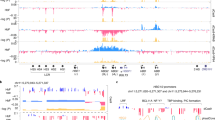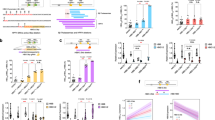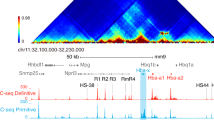Abstract
The contribution of changes in cis-regulatory elements or trans-acting factors to interspecies differences in gene expression is not well understood. The mammalian β-globin loci have served as a model for gene regulation during development. Transgenic mice containing the human β-globin locus, consisting of the linked embryonic (ε), fetal (γ) and adult (β) genes, have been used as a system to investigate the temporal switch from fetal to adult haemoglobin, as occurs in humans. Here we show that the human γ-globin (HBG) genes in these mice behave as murine embryonic globin genes, revealing a limitation of the model and demonstrating that critical differences in the trans-acting milieu have arisen during mammalian evolution. We show that the expression of BCL11A, a repressor of human γ-globin expression identified by genome-wide association studies, differs between mouse and human. Developmental silencing of the mouse embryonic globin and human γ-globin genes fails to occur in mice in the absence of BCL11A. Thus, BCL11A is a critical mediator of species-divergent globin switching. By comparing the ontogeny of β-globin gene regulation in mice and humans, we have shown that alterations in the expression of a trans-acting factor constitute a critical driver of gene expression changes during evolution.
This is a preview of subscription content, access via your institution
Access options
Subscribe to this journal
Receive 51 print issues and online access
$199.00 per year
only $3.90 per issue
Buy this article
- Purchase on Springer Link
- Instant access to full article PDF
Prices may be subject to local taxes which are calculated during checkout




Similar content being viewed by others
References
Carroll, S. B. Evo-devo and an expanding evolutionary synthesis: a genetic theory of morphological evolution. Cell 134, 25–36 (2008)
Hoekstra, H. E. & Coyne, J. A. The locus of evolution: evo devo and the genetics of adaptation. Evolution 61, 995–1016 (2007)
Wallace, H. A. et al. Manipulating the mouse genome to engineer precise functional syntenic replacements with human sequence. Cell 128, 197–209 (2007)
Wilson, M. D. et al. Species-specific transcription in mice carrying human chromosome 21. Science 322, 434–438 (2008)
McGrath, K. & Palis, J. Ontogeny of erythropoiesis in the mammalian embryo. Curr. Top. Dev. Biol. 82, 1–22 (2008)
Wijgerde, M., Grosveld, F. & Fraser, P. Transcription complex stability and chromatin dynamics in vivo . Nature 377, 209–213 (1995)
Peterson, K. R., Navas, P. A., Li, Q. & Stamatoyannopoulos, G. LCR-dependent gene expression in β-globin YAC transgenics: detailed structural studies validate functional analysis even in the presence of fragmented YACs. Hum. Mol. Genet. 7, 2079–2088 (1998)
Porcu, S. et al. The human β globin locus introduced by YAC transfer exhibits a specific and reproducible pattern of developmental regulation in transgenic mice. Blood 90, 4602–4609 (1997)
Peschle, C. et al. Haemoglobin switching in human embryos: asynchrony of ζ→α and ε→γ-globin switches in primitive and definite erythropoietic lineage. Nature 313, 235–238 (1985)
Sloane-Stanley, J., Roberts, N. A., Olivieri, N., Weatherall, D. J. & Wood, W. G. Globin gene expression in Hb Lepore-BAC transgenic mice. Br. J. Haematol. 135, 735–737 (2006)
Pace, B., Li, Q., Peterson, K. & Stamatoyannopoulos, G. α-Amino butyric acid cannot reactivate the silenced γ gene of the β locus YAC transgenic mouse. Blood 84, 4344–4353 (1994)
Papayannopoulou, T., Torrealba de Ron, A., Veith, R., Knitter, G. & Stamatoyannopoulos, G. Arabinosylcytosine induces fetal hemoglobin in baboons by perturbing erythroid cell differentiation kinetics. Science 224, 617–619 (1984)
Weatherall, D. J. et al. Foetal erythropoiesis in human leukaemia. Nature 257, 710–712 (1975)
Kingsley, P. D. et al. “Maturational” globin switching in primary primitive erythroid cells. Blood 107, 1665–1672 (2006)
Fraser, S. T., Isern, J. & Baron, M. H. Maturation and enucleation of primitive erythroblasts during mouse embryogenesis is accompanied by changes in cell-surface antigen expression. Blood 109, 343–352 (2007)
Ragoczy, T., Bender, M. A., Telling, A., Byron, R. & Groudine, M. The locus control region is required for association of the murine β-globin locus with engaged transcription factories during erythroid maturation. Genes Dev. 20, 1447–1457 (2006)
Trimborn, T., Gribnau, J., Grosveld, F. & Fraser, P. Mechanisms of developmental control of transcription in the murine α- and β-globin loci. Genes Dev. 13, 112–124 (1999)
Chada, K., Magram, J. & Costantini, F. An embryonic pattern of expression of a human fetal globin gene in transgenic mice. Nature 319, 685–689 (1986)
Uda, M. et al. Genome-wide association study shows BCL11A associated with persistent fetal hemoglobin and amelioration of the phenotype of β-thalassemia. Proc. Natl Acad. Sci. USA 105, 1620–1625 (2008)
Lettre, G. et al. DNA polymorphisms at the BCL11A, HBS1L-MYB, and β-globin loci associate with fetal hemoglobin levels and pain crises in sickle cell disease. Proc. Natl Acad. Sci. USA 105, 11869–11874 (2008)
Menzel, S. et al. A QTL influencing F cell production maps to a gene encoding a zinc-finger protein on chromosome 2p15. Nature Genet. 39, 1197–1199 (2007)
Sedgewick, A. E. et al. BCL11A is a major HbF quantitative trait locus in three different populations with β-hemoglobinopathies. Blood Cells Mol. Dis. 41, 255–258 (2008)
Sankaran, V. G. et al. Human fetal hemoglobin expression is regulated by the developmental stage-specific repressor BCL11A . Science 322, 1839–1842 (2008)
Liu, P. et al. Bcl11a is essential for normal lymphoid development. Nature Immunol. 4, 525–532 (2003)
Sankaran, V. G., Orkin, S. H. & Walkley, C. R. Rb intrinsically promotes erythropoiesis by coupling cell cycle exit with mitochondrial biogenesis. Genes Dev. 22, 463–475 (2008)
Zhang, J., Socolovsky, M., Gross, A. W. & Lodish, H. F. Role of Ras signaling in erythroid differentiation of mouse fetal liver cells: functional analysis by a flow cytometry-based novel culture system. Blood 102, 3938–3946 (2003)
Johnson, R. M. et al. Phylogenetic comparisons suggest that distance from the locus control region guides developmental expression of primate β-type globin genes. Proc. Natl Acad. Sci. USA 103, 3186–3191 (2006)
Peterson, K. R. et al. Transgenic mice containing a 248-kb yeast artificial chromosome carrying the human β-globin locus display proper developmental control of human globin genes. Proc. Natl Acad. Sci. USA 90, 7593–7597 (1993)
Harju, S., Navas, P. A., Stamatoyannopoulos, G. & Peterson, K. R. Genome architecture of the human β-globin locus affects developmental regulation of gene expression. Mol. Cell. Biol. 25, 8765–8778 (2005)
Gaensler, K. M., Kitamura, M. & Kan, Y. W. Germ-line transmission and developmental regulation of a 150-kb yeast artificial chromosome containing the human β-globin locus in transgenic mice. Proc. Natl Acad. Sci. USA 90, 11381–11385 (1993)
Strouboulis, J., Dillon, N. & Grosveld, F. Developmental regulation of a complete 70-kb human β-globin locus in transgenic mice. Genes Dev. 6, 1857–1864 (1992)
Chan, I. T. et al. Conditional expression of oncogenic K-ras from its endogenous promoter induces a myeloproliferative disease. J. Clin. Invest. 113, 528–538 (2004)
Braun, B. S. et al. Somatic activation of oncogenic Kras in hematopoietic cells initiates a rapidly fatal myeloproliferative disorder. Proc. Natl Acad. Sci. USA 101, 597–602 (2004)
Garrick, D. et al. Loss of Atrx affects trophoblast development and the pattern of X-inactivation in extraembryonic tissues. PLoS Genet. 2, e58 (2006)
Jasinski, M., Keller, P., Fujiwara, Y., Orkin, S. H. & Bessler, M. GATA1-Cre mediates Piga gene inactivation in the erythroid/megakaryocytic lineage and leads to circulating red cells with a partial deficiency in glycosyl phosphatidylinositol-linked proteins (paroxysmal nocturnal hemoglobinuria type II cells). Blood 98, 2248–2255 (2001)
Walkley, C. R., Fero, M. L., Chien, W. M., Purton, L. E. & McArthur, G. A. Negative cell-cycle regulators cooperatively control self-renewal and differentiation of haematopoietic stem cells. Nature Cell Biol. 7, 172–178 (2005)
Choi, J. W., Kim, Y., Fujino, M. & Ito, M. A new anti-hemoglobin F antibody against synthetic peptides for the detection of F-cell precursors (F-blasts) in bone marrow. Int. J. Hematol. 74, 277–280 (2001)
Bolland, D. J. et al. Antisense intergenic transcription in V(D)J recombination. Nature Immunol. 5, 630–637 (2004)
Acknowledgements
We are grateful to K. Peterson and H. Fedosyuk for providing β-locus mice, K. Gaensler for the A20 and A85 strains of β-locus mice, and T. Jacks for providing the K-RasG12D mice. We thank J. Palis and P. Kingsley for providing mouse embryonic globin antibodies, H. Mikkola and B. Van Handel for providing sorted human samples, and R. Byron and A. Telling for technical support. We thank L. Zon, K. McGrath, P. Kingsley, J. Palis, M. Kowalczyk and T. Menne for advice and discussions. This work was supported by funding from the National Institute of Diabetes and Digestive and Kidney Diseases (NIDDK) and the National Heart, Lung, and Blood Institute (NHLBI) of the National Institutes of Health (NIH) (S.H.O. and M.G.) and the National Cancer Institute (P.W.T.). S.H.O. is an Investigator of the Howard Hughes Medical Institute (HHMI). C.R.W. is a special fellow of the Leukemia & Lymphoma Society. T.R. is supported by a fellowship from the American Society of Hematology. J.X. is an HHMI fellow of the Helen Hay Whitney Foundation. V.G.S. is supported by a Medical Scientist Training Program Award from the NIH and G.C.I. is supported by a NCI postdoctoral fellowship.
Author Contributions V.G.S., J.X. and S.H.O. conceived the study design. V.G.S., J.X., T.R., C.R.W., Y.F., M.I. and M.A.B. performed the experiments. V.G.S., J.X., T.R., C.R.W., M.G., M.A.B. and S.H.O. analysed data. G.C.I., S.D.M. and P.W.T. developed and contributed a new mouse line. V.G.S., J.X. and S.H.O. wrote the paper. All authors read, helped revise, and approved the manuscript.
Author information
Authors and Affiliations
Corresponding author
Ethics declarations
Competing interests
V.G.S. and S.H.O. are inventors on a patent filed by the Children’s Hospital of Boston related to the therapeutic targeting of BCL11A for induction of fetal haemoglobin in humans.
Supplementary information
Supplementary Information
This file contains Supplementary Notes, Supplementary References and Supplementary Figures 1-10 with Legends. (PDF 4340 kb)
Rights and permissions
About this article
Cite this article
Sankaran, V., Xu, J., Ragoczy, T. et al. Developmental and species-divergent globin switching are driven by BCL11A. Nature 460, 1093–1097 (2009). https://doi.org/10.1038/nature08243
Received:
Accepted:
Published:
Issue Date:
DOI: https://doi.org/10.1038/nature08243
This article is cited by
-
SWI/SNF complexes in hematological malignancies: biological implications and therapeutic opportunities
Molecular Cancer (2023)
-
Endogenous bioluminescent reporters reveal a sustained increase in utrophin gene expression upon EZH2 and ERK1/2 inhibition
Communications Biology (2023)
-
Metabolic sensor O-GlcNAcylation regulates erythroid differentiation and globin production via BCL11A
Stem Cell Research & Therapy (2022)
-
Epigenomic analysis of KLF1 haploinsufficiency in primary human erythroblasts
Scientific Reports (2022)
-
Establishment of an immortalized human erythroid cell line sustaining differentiation potential without inducible gene expression system
Human Cell (2022)
Comments
By submitting a comment you agree to abide by our Terms and Community Guidelines. If you find something abusive or that does not comply with our terms or guidelines please flag it as inappropriate.



